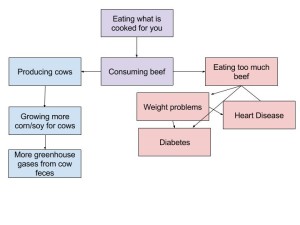- Create a systems diagram that links HIPPO to the loss of biodiversity.
- In a paragraph of 200-300 words, explain the ideas behind your diagram.
- In another paragraph of 200-300 words, draw on concepts from this module and others to determine what we can do to decrease the loss of biodiversity.
In my systems diagram, I illustrated how the concept called H.I.P.P.O. impacts the loss of biodiversity. With the large increase in population over the last two-hundred or so years, there has been an increase in many industrial activities. Through this, there has been an over-harvesting of many plants and animals just to feed the population. This action has led to the endangerment and extinction of many animals. Mainly because they are being killed but because their habitats are being taken away. Since there is a huge loss of habitats, many animals are dying off because they do not have a place to live. Another setback of industrial activities is the increase in pollution. This increase in pollution has lead to many things such as bioaccumulation which impacts many of the animals that are higher up in the food chain because they are consuming other animals that have been impacted by pollution. Bioaccumulation also leads to a larger loss in biodiversity. Pollution also leads to a huge increase in climate change which aids in the destruction of habitats. Another impact that climate change has is the migration of animals to different parts of the world. Since many parts of the world are getting warmer, more species that can migrate large distances are finding their way to said places. Because they are new to these places, the species that are already there are not used to some of them. These new species can have a detrimental impact on animals leading to a larger loss in biodiversity.
There are many things that we can do to impact biodiversity. When looking at the previous module, we can take what we learned about different ways climate change has impacted the world and try and find ways to decrease it. Climate change happens for many reasons, most of them are because of the greenhouse gases that are emitted into the atmosphere. By looking for different ways to cut down on them, we as humans can help save biodiversity. Although we can not undo what we have done, we can move forward and make a huge difference in the animal kingdom. A major thing that we can do is to stop destroying habitats and start building them again. By planting trees in the rain forest, we can preserve the homes of the animals that live there. Through using less fossil fuels, we can stop releasing so many greenhouse gases into the air which will help with the issue of global warming. This can help preserve the home of those animals that live in the arctic and need a cold climate to live in. We can help developing countries towards their goal of a better standard of living that way they can stop the harmful things they may be doing to the environment such as cutting down trees to fuel their homes. If we all work together as a team, we can help save the planet and the biodiversity that comes along with it.




